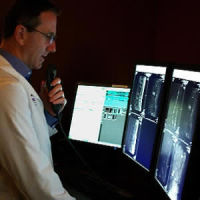Minute traces of gadolinium, the contrast agent used to enhance MR images, are often retained in the brain tissue of patients years after undergoing MRI. New research suggests however that gadolinium retention may be more widespread and may be present in many more, or possibly all, patients exposed to gadolinium-based contrast agents. The findings, published in the journal Radiology, refute the common belief that the deposition is limited to patients with underlying brain pathology, such as a tumour or infection.
Gadolinium contrast media were introduced as a means of enhancing MRI images in 1988 and are commonly used today. The contrast agent is injected into the patient's bloodstream and eliminated from the body through the kidneys. Scientists previously believed gadolinium contrast material could not cross intact blood brain barrier, the semipermeable membrane that selectively filters materials from the bloodstream from entering extracellular fluid in the brain and central nervous system.
"By late 2014, the first evidence emerged that gadolinium was depositing within brain tissues. However, many of these patients had underlying medical conditions, such as brain tumours, that could adversely affect the blood brain barrier," said lead author Robert J. McDonald, MD, PhD, staff neuroradiologist at the Mayo Clinic in Rochester, Minn. "We were curious if this deposition might be related to the integrity of the blood brain barrier, so we studied patients with normal brain pathology and presumably an intact blood brain barrier."
The study involved an analysis of post-mortem neuronal tissue samples from five patients who had undergone four or more (up to 18) gadolinium-enhanced MRI exams between 2005 and 2015 and 10 patients who had undergone MRI exams without gadolinium. The median age at the time of death was 68 years in the contrast agent-exposed group and 79 years in the control group. All patients in the current study were exposed to gadodiamide (Omniscan).
During the patient autopsies, a small amount of brain tissue was obtained from each patient and studied with transmission electron microscopy, mass spectroscopy and X-ray spectroscopy. The analysis revealed dose-dependent gadolinium deposits in four neuroanatomical regions of the brain in patients who underwent contrast-enhanced MRI. At the time of autopsy, all study patients had normal brain pathology.
"Our results suggest current thinking with regard to the permeability of the blood brain barrier is greatly oversimplified, as gadolinium appears to accumulate even among patients with normal brain tissue and no history of intracranial pathology." Dr. McDonald pointed out. "It will take additional research to understand how and why this deposition is occurring."
Despite finding evidence of gadolinium contrast agent deposition in the neural tissues, the researchers detected no histologic changes to suggest toxicity. The FDA has identified no convincing scientific evidence to date that these deposits are harmful, but is further investigating this matter.
Source: Radiological Society of North America
Image Credit: W. Oelen
References:
McDonald, J. Robert et al. (2017) Comparison of Gadolinium Concentrations within Multiple Rat Organs after Intravenous Administration of Linear versus Macrocyclic Gadolinium Chelates. Radiology; DOI: 10.1148/radiol.2017161594
Latest Articles
Gadolinium Deposition, Brain Tissues, gadolinium-based contrast agents
New research suggests however that gadolinium retention may be more widespread and may be present in many more, or possibly all, patients exposed to gadolinium-based contrast agents.

























